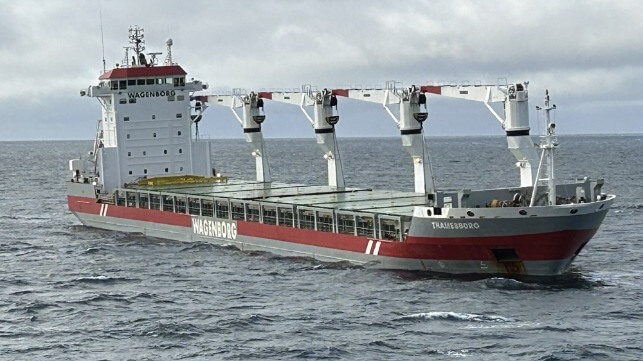Effort This Week Will Attempt to Refloat Ship Stranded in Canadian Arctic

With the arrival of additional equipment and lightening of the vessel Thamesborg completed, Royal Wagenborg and the Canadian Coast Guard report a refloating operation is scheduled for this week. The teams remain focused on the safe recovery operation while racing to complete the effort ahead of the onset of winter weather.
The crew of 15 and an ice advisor remain aboard the vessel, and there are no reports of pollution as the effort enters its fifth week. The Thamesborg went aground in a remote part of the Canadian Arctic on September 6 while transiting the Franklin Strait off Prince of Wales Island, Nunavut, Canada. The fuel tanks and cargo holds remained intact, although several ballast tankers were damaged.
During the first stage of the salvage operation, around 4,000 tons of cargo, carbon blocks for industrial use, were transferred from the Thamesborg to two other vessels, Silver Copenhagen and Nulavik, that were brought in to aid with the operation. The vessel’s operator, Royal Wagenborg, reports that the goal was to reduce the draft of the grounded ship, and if the effort is unsuccessful, the resources are available to remove additional cargo.
Additional equipment and personnel reached the site on October 3 with the MSV Botnica, an offshore support vessel, which was brought from Europe to aid with the effort. The OSV made stops en route to load additional supplies and provisions before proceeding into the Arctic. The vessel will be able to assist with escorting operations, towing, or potentially icebreaking as the operation proceeds.
One of the challenges emphasized during a briefing on October 6 is the weather conditions in the area. Representatives for Environment and Climate Change Canada and the Canadian Ice Service highlighted that the storm season is beginning in the region. Today, they said, there are strong winds near the site, but they expected a brief lessening early in the week. Strong winds and snow were forecasted for later in the week, but the Canadian Ice Service noted that the heaviest ice is to the west of the location.
The Canadian Coast Guard vessel CCGS Des Groseilliers remains on site, providing oversight and weather and ice forecasts. The observation efforts vary by the weather each day, while T&T Salvage has been retrained by Wagenborg for the operation. The Coast Guard has also used its crew changes as opportunities to bring additional supplies and expert personnel to the area.
Wagenborg notes the vessel has an ice class hull. The operation this week will reduce the water that flooded into the empty ballast tanks when the vessel grounded in an effort to refloat the ship. If it is successful, the vessel will undergo an inspection to determine the level of damage, and efforts are identifying ports of refuge. The goal is for the ship to sail under its own power, but resources are there to assist if needed. The course out of the Arctic is still being discussed and will be determined based on weather and ice conditions.
The company said there is a contingency plan if they cannot free the vessel before the onset of winter and ice forms to prevent the removal of the ship. However, the focus is on refloating the vessel, and they are confident the Thamesborg can be removed before the conditions prevent its exit from the region. The timing of this week’s refloating effort and the completion of the removal depend on favorable weather and sea conditions.
Canadian law requires the vessel's owner to pay for the salvage as well as repairs and damage to the environment. A spokesperson for the company reaffirmed that Royal Wagenborg maintains comprehensive maritime industry insurance coverage, including Protection and Indemnity (P&I) insurance and Hull & Machinery (H&M) insurance on all its vessels and it is "confident these industry safeguards will serve their designed purpose in this instance."
Wagenborg highlights that since 2016, it has completed over 50 successful commercial transits of the Northwest Passage. They are working with the authorities for an investigation and expect to learn from this incident. The company remains committed to the use of the Arctic as an important sea lane, saying that one incident does not change its overall operations.
